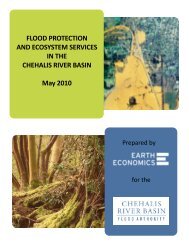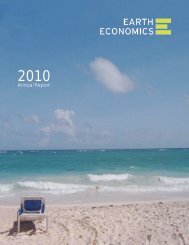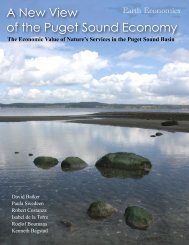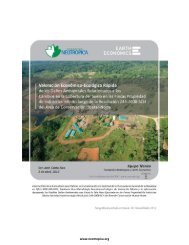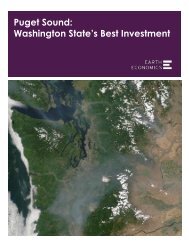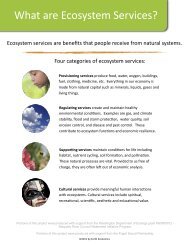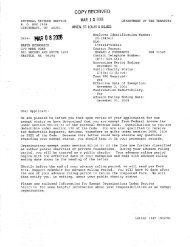The Spot Prawn Fishery: A Status Report - Earth Economics
The Spot Prawn Fishery: A Status Report - Earth Economics
The Spot Prawn Fishery: A Status Report - Earth Economics
You also want an ePaper? Increase the reach of your titles
YUMPU automatically turns print PDFs into web optimized ePapers that Google loves.
<strong>The</strong> <strong>Spot</strong> <strong>Prawn</strong> <strong>Fishery</strong>: A <strong>Status</strong> <strong>Report</strong><br />
•Retained spot prawns must have a minimum<br />
carapace length of 30 mm (1.18 in.), except in<br />
Districts 3 (Port Angeles Harbor) and 5 (Hood<br />
Canal). A pot mesh restriction of 7/8 in. in Hood<br />
Canal regulates that the carapaces of most<br />
prawns caught are longer than about 30 mm.<br />
•All spot prawns landed must be sold to licensed<br />
Washington State wholesale fish dealers. <strong>Spot</strong><br />
prawns may not be landed without immediate<br />
delivery to a licensed wholesale dealer; or, if<br />
transferred at sea, without transfer to a licensed<br />
wholesale dealer.<br />
•All pot gear must possess biodegradable escape<br />
mechanisms.<br />
•<strong>The</strong> San Juan Island Marine Preserve, Shrimp<br />
District 4 (Sequim Bay), and Catch Area 28B<br />
(Carr Inlet) are closed to all shrimp [prawn]<br />
harvest.<br />
•Shrimp Districts 1 and 3 and Hood Canal are<br />
closed to all non-Tribal commercial shrimp<br />
harvest.<br />
•Recreational fishers in Hood Canal are restricted<br />
to a daily limit of 80 spot prawns, a pot limit of<br />
one pot per person and four pots per boat, and a<br />
four-hour fishing day (9:00 a.m.–1:00 p.m.) on<br />
selected days of the week.<br />
•<strong>The</strong> harvest allocation for the State spot prawn<br />
fishery in CMR 2 and 4 (Central Sound/Whidbey<br />
Basin) is 40% commercial, 60% recreational.<br />
•Quota overages must be deducted from the next<br />
year’s quota in order to pay “the overharvest<br />
back to the resource” (WDFW 1998).<br />
•State commercial shrimp pots cannot be fished<br />
in more than one Marine Fish–Shellfish Management<br />
and Catch <strong>Report</strong>ing Area per day. Pots<br />
can be moved to other areas if a harvest report is<br />
made before the gear is moved and the number<br />
of pots being moved and the area they are being<br />
moved to are specified.<br />
•State commercial pots cannot be set or pulled<br />
from a Marine Fish–Shellfish Management and<br />
Catch <strong>Report</strong>ing Area if the fisher is in possession<br />
of shrimp harvested from another Area.<br />
•Both the Tribes and the State will collect and<br />
compile harvest data. This information is to be<br />
shared on the first and 15th of every month the<br />
fishery is open. When the total harvest in any<br />
area reaches 80% of the quota, commercial harvest<br />
data must be exchanged every Monday for<br />
the remainder of the time the fishery is open.<br />
•Total Tribal catches will be reported by:<br />
1. <strong>The</strong> Lummi Tribe—Management Area 1<br />
2. <strong>The</strong> Tulalip Tribe—Management Area 2<br />
3. <strong>The</strong> Elwha S’Klallam Tribe—Management<br />
Area 3<br />
4. <strong>The</strong> Suquamish Tribe—Management Area 4<br />
5. Tribe(s) to be determined, if necessary—<br />
Management Area 6<br />
•Fishers are required to submit monthly harvest<br />
logs to Tribal or WDFW biologists. Logs will<br />
detail, among other data, the number of pots,<br />
soak times, Catch Area, location fished, pounds<br />
landed by species, and total pounds landed. This<br />
information must be recorded immediately after<br />
a pot or string of pots is pulled. Harvest logs are<br />
numbered and must be used and submitted in<br />
consecutive order.<br />
•Daily commercial catches must be hailed by<br />
telephone each day prior to leaving the catch<br />
site. Hailing reports should include the fisher’s<br />
name, the Catch Area fished, the total number<br />
of pots fished, total number of pots pulled, the<br />
total pounds of prawns caught, and the port<br />
where the catch will be landed.<br />
•Landings from Fish Receiving Tickets are used<br />
to assess the annual Tribal and non-Tribal commercial<br />
harvests.<br />
•For the State commercial fishery, all buyers of<br />
spot prawns, including fishers that buy their<br />
own catch, must call WDFW each Monday by<br />
10:00 a.m. to report their total purchases from<br />
the previous week.<br />
•<strong>The</strong> State and Tribes will collect information on<br />
recreational, ceremonial, and subsistence harvests.<br />
In addition, the State will carry out surveys<br />
to evaluate total recreational catch and effort in<br />
key fishing areas. <strong>The</strong>se data will be used to estimate<br />
total non-commercial catch and will be<br />
included in the setting of State and Tribal harvest<br />
shares (quotas).<br />
•Following the close of the commercial fishing<br />
seasons, a Tribal/State Shrimp technical group<br />
will “assess the season including harvest by fish-<br />
34



